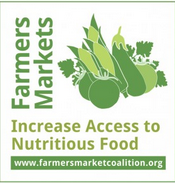Farmers Markets Increase Access to Fresh, Nutritious Food
 Farmers Markets Increase Access to Fresh, Nutritious Food
Farmers Markets Increase Access to Fresh, Nutritious Food
Everyone should have access to nutritious food. It sustains our well-being and makes it possible for us to pursue happy, healthy lives. But nutritious food is not always available – or affordable – especially for the millions of American families in low-income neighborhoods, struggling daily to make ends meet. Due to cost and access, fresh fruits and vegetables are a luxury many Americans can’t spare to indulge.
Farmers markets are expanding access to fresh, healthy food by offering competitive prices and special programs for low-income families in communities that need it most. Farmers markets put fruits and vegetables front and center and create an shopping environment where nutritious foods are not only affordable, but celebrated.
According to the USDA, over 5,000 farmers markets across the country now accept Supplemental Nutrition Assistance Program (SNAP) benefits, with new locations accepting SNAP increasing at an average rate of 40% per year. [i] This brings more and more fresh, local produce to low-income neighborhoods and enables SNAP recipients to purchase the nutritious food their families need to stay healthy. A growing number of farmers markets also offer incentive programs to low-income seniors and SNAP and WIC (Women, Infants and Children Program) customers. These programs provide participants with coupons or vouchers they can redeem for more fresh produce, increasing the capacity for struggling families to purchase and eat more fruits and vegetables.
Small farmers and vendors are also welcoming the spike in business. The USDA reports that the number of SNAP households shopping at farmers markets increased by 52% since 2011, spending $18.8 million with local farmers in 2014 – 4 times as much as in 2009. Shopping at the farmers market is a win-win for farmers and low-income communities; they stimulate business for farmers by improving access to fresh, healthy food for families in need.
Markets Increasingly Accept SNAP and SNAP Recipients Increasingly Shop at Markets
- In 2014, 362,477 SNAP households made at least one purchase at a farmers market.
- In 2014, over 5,000 markets and farmers accepted SNAP benefits. Some states that help farmers markets accept SNAP saw a ten-fold increase in the number of markets accepting SNAP between 2009 and 2014. [ii], [iii]
- The amount of SNAP benefits redeemed at farmers markets increased nearly 450% from 2009 ($4.2 million) to 2014 ($18.8 million). [iv]
- In 2014, 42 farmers markets in Washington, D.C. accepted EBT and credit/debit cards, up from 7 in 2010. [v]
SNAP and Other Nutrition Benefits Improve Nutrition Redemption
- Of 216 shoppers surveyed at the Janesville, Wisconsin Farmers Market in 2012, 98% said that they would eat more fruits and vegetables as a result of their SNAP benefits and 30% said that they had not shopped at the market before SNAP benefits were accepted. [vi]
- In 2012, New York City’s farmers markets distributed over $280,000 in Health Bucks, a health incentive coupon, to SNAP participants. Nearly three-quarters of Health Bucks users reported that the coupons made them more likely to buy fresh produce. [vii]
- More than 1.5 million WIC participants and 835,795 low-income seniors bought fresh produce directly from farmers in 2013 through the WIC and Senior Farmers Market Nutrition Programs. [viii]
Farmers Market Prices are Affordable and Competitive
- A 2015 USDA report found that “produce prices at DTC [direct-to-consumer] outlets are lower, on average, than prices at grocery stores in all seasons.” [xii]
- At farmers markets in low-income areas, 6 in 10 shoppers said that they could find better prices at the markets than at their grocery.
- A 2011 study of southeast and Appalachia markets found that in 74% of communities, conventional farmers market produce was less expensive than supermarket produce, on average by 22%. [ix]
- In one study, average produce prices were 17.9% lower at farmers’ markets than at supermarkets in 12 North Carolina counties. [x]
- A Vermont study found that prices for many conventional products and all organic products, with the exception of potatoes, were lower at farmers markets than at nearby supermarkets. [xi]
